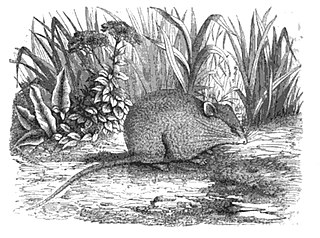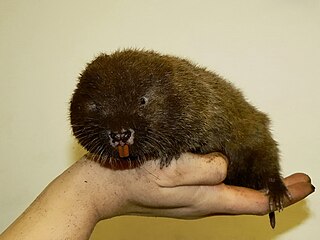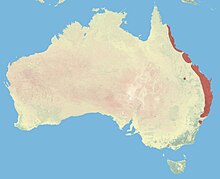
The bush rat or Australian bush rat is a small Australian nocturnal animal. It is an omnivore and one of the most common indigenous species of rat on the continent, found in many heathland areas of Victoria and New South Wales.

Gould's mouse, also known as the Shark Bay mouse and djoongari in the Pintupi and Luritja languages, is a species of rodent in the murid family. Once ranging throughout Australia from Western Australia to New South Wales, its range has since been reduced to five islands off the coast of Western Australia.

The giant white-tailed rat is an Australian rodent native to tropical rainforest of north Queensland, with subspecies occurring in New Guinea and the Aru Islands. It is one of the largest rodents in Australia, reaching up to 1 kg in weight. It is grey-brown above, cream to white below, and has a long, naked tail of which the distal section is white.
The West African shaggy rat is a species of rodent in the family Muridae. It is found in Benin, Cameroon, Ivory Coast, Gambia, Ghana, Guinea, Guinea-Bissau, Liberia, Mali, Nigeria, Senegal, Sierra Leone, and Togo. Its natural habitats are subtropical or tropical seasonally wet or flooded lowland grassland and swamps. It is a common species and the International Union for Conservation of Nature has rated its conservation status as being of "least concern".

Melomys is a genus of rodents in the family Muridae. Members of this genus live in the wet habitats of northern Australia, New Guinea, Torres Strait Islands and islands of the Indonesian archipelago.
The Cape York mosaic-tailed rat, or Cape York melomys is a species of rodent in the family Muridae. It is found only in Australia, on the Cape York Peninsula.

The Bramble Cay melomys, or Bramble Cay mosaic-tailed rat, is a recently extinct species of rodent in the family Muridae and subfamily Murinae. It was an endemic species of the isolated Bramble Cay, a low-lying vegetated coral cay with a habitable area of approximately 5 acres (2.0 ha) located at the northern tip of the Great Barrier Reef in Australia. Described by researchers as having last been seen in 2009 and declared extinct by the Queensland Government and University of Queensland researchers in 2016, it was formally declared extinct by the International Union for Conservation of Nature (IUCN) in May 2015 and the Australian government in February 2019. Having been the only mammal endemic to the reef, its extinction was described as the first extinction of a mammal species due to anthropogenic climate change.

The black-tailed mosaic-tailed rat or black-tailed melomys is a species of rodent in the family Muridae. It is found through much of New Guinea and also on some nearby islands, namely Salawati and Misool (Indonesia), and the Bismarck Archipelago.

The golden-backed tree rat is a species of rodent in the family Muridae, found only in Australia.

The ash-grey mouse is a rodent in the family Muridae. Larger and more robust than Mus musculus, the common house mouse, it is found only in Southwest Australia.
The masked white-tailed rat is a species of rodent in the family Muridae. It is found only in Australia, in north-east Queensland.

Xeromys myoides, also known as the water mouse, marine mouse, mangrove mouse, false water rat, manngay and yirrkoo, is a species of rodent native to waterways of Australia and Papua New Guinea.

The lesser bamboo rat is a species of rodent in the family Spalacidae. It is monotypic within the genus Cannomys. It is found in Bangladesh, Bhutan, Cambodia, China, India, Myanmar, Nepal, and Thailand.

Alpinia caerulea, commonly known as native ginger or Australian ginger, is an understorey perennial herb in the family Zingiberaceae which grows in rainforest, gallery forest and wet sclerophyll forest in eastern Australia.
Bannister's rat, or great Key Island mosaic-tailed rat, or great Key Island melomys or great Kai Island melomys is a species of rodent of the genus Melomys. It is endemic to the Kai Besar, one of the islands which are part of the Maluku Islands, Indonesia.
The long-nosed paramelomys is a species of rodent of the family Muridae endemic to New Guinea. It is found in the lowlands of the south of the country.
The short-tailed Talaud mosaic-tailed rat or the short-tailed Talaud melomys is a species of rodent in the family Muridae. It is endemic to Karakelong and Salebabu in the Talaud Islands in Indonesia where it occurs in forest habitats. The long-tailed Talaud mosaic-tailed rat is also present on the islands and the shorter tail of this species means that it is likely to be mainly terrestrial whereas M. talaudium is largely arboreal.
The long-tailed Talaud mosaic-tailed rat or the long-tailed Talaud melomys is a species of rodent in the family Muridae. It is endemic to Karakelong and Salebabu in the Talaud Islands in Indonesia where it occurs in forest habitats. It is morphologically similar to the white-bellied mosaic-tailed rat and was at one time considered to be a subspecies but is now recognised as a distinct species. The short-tailed mosaic-tailed rat is also present on the islands and the shorter tail of that species means that it is likely to be mainly terrestrial whereas M. talaudium is largely arboreal.

Hydromyini is a very large, diverse tribe of muroid rodents in the subfamily Murinae. They are the dominant native rodents in Australasia and one of only two native rodent groups there, the other being the R. fuscipes group of the genus Rattus in the tribe Rattini. They are also found in parts of Southeast Asia.













